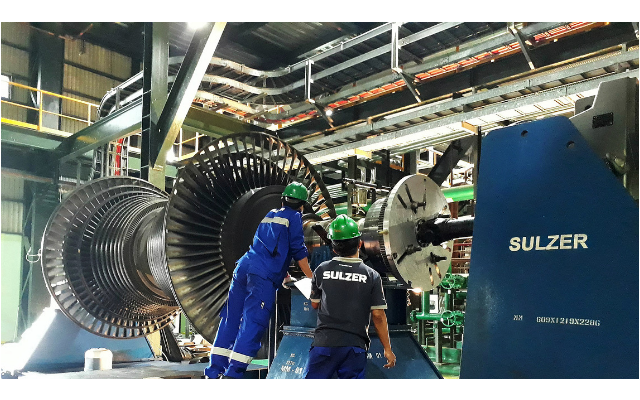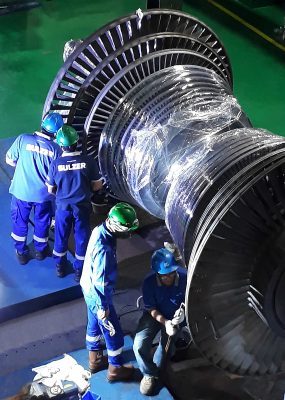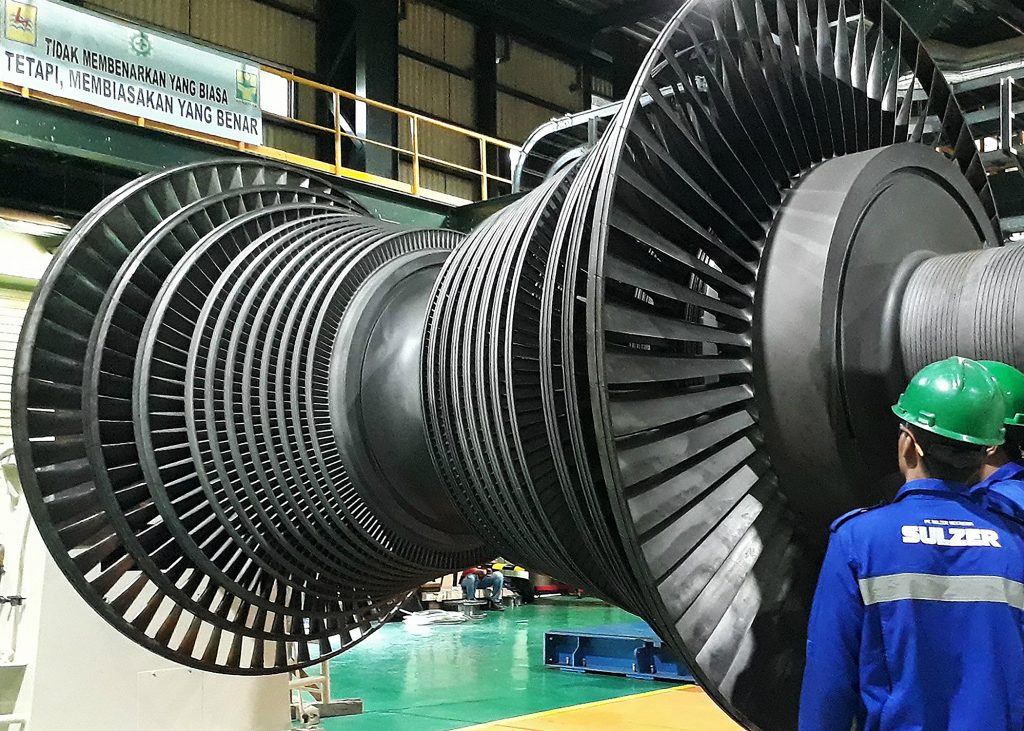Contributor: Claudia Proeger, Marketing and Communications, Rotating Equipment Services, Sulzer Management Ltd
Sulzer’s mobile repair equipment reduces downtime to just 45 days
Geothermal sites are often located in areas that are difficult to access. In this case, a power station in Indonesia in a mountainous area 780 meters above sea level with narrow access roads needed a steam turbine overhauled. Sulzer was chosen to overhaul the 55 MW steam turbine-generator as a result of its expertise, experience and ability to minimize the project duration by sending its mobile repair equipment to the power station.
Routine maintenance is essential for all pieces of rotating equipment, but steam turbines are far from small, making them difficult to transport to a workshop for repairs – especially geothermal steam turbines. To improve the repair process, Sulzer in Indonesia has developed a range of mobile repair machinery that, together with expert engineers, is fully equipped to refurbish steam turbines on-site.
Planning ahead
With the world’s largest reserves of geothermal energy, Indonesia is hoping to increase its use of this renewable energy source. At the same time, the power stations that are already in operation need to maintain their reliability with planned maintenance routines.
Kusno Baryadi, Field Engineer for Sulzer in Indonesia, comments: “Geothermal steam turbines operate in a particularly challenging environment, where chemical erosion can have a detrimental effect on their performance. In order to ensure their continued reliability and efficiency, steam turbines should be overhauled every four to five years.”
Sending the steam turbine rotor to the workshop was quite risky due to the power plant’s remote location and unsuitable roads, it was therefore decided to perform the overhaul and repair on site. This would also achieve a considerable saving in downtime for the steam turbine, which minimizes costs associated with the refurbishment project.
Mobile expertise
Effective planning is essential to complete such a project on time. For the power station, the 45-day maintenance window was established, and Sulzer was expected to meet the deadline. Before the generator was taken offline, Sulzer engineers worked with staff at the power plant to organize the most effective method of completing the work.
Sulzer in Indonesia has developed mobile repair equipment that consists of a complete set of portable tools including lathes, balancing machines and welding equipment that can be mobilized efficiently. This reduces transportation costs for the customer as well as potential rotor damage risk, which means insurance costs are also minimized.
All the necessary spare parts were assembled along with the mobile machine tools and balancing equipment, all of which was packed into four trucks for transport to the power station. As soon as the trucks arrived the lathe and the balancing machine were set up, while the rest of the team started to disassemble the upper casing of the turbine.
Detailed inspection
Once the rotor was removed from the casing it was set up on the lathe, where the dimensional inspection, runout checks and non-destructive testing could be performed. Part of this inspection showed that the L-0 and L-1 blades would need to have their erosion shields replaced, which would be possible as their design allows them to be brazed into position.
Erosion shields are typically attached on the leading edges of steam turbine blades in the final rows of the low-pressure section that protect the airfoils from erosion. They reduce wear on the blades caused by cavitation erosion from condensed water particles in the steam.
For repairs where only the original erosion shield has been worn and not the blade material, the first step is to remove what remains of the erosion shields that are typically made from cobalt base material. Having sand-blasted and cleaned the blade recess, a replacement can be installed using a special jig and heating elements. The specific pressure and temperature applied during the installation process is determined by the bonding material in use.
Perfect balance
The inspection also revealed that the labyrinth seal strips needed replacing on one turbine-side stage and four generator-side stages. All of these seals and the erosion shields underwent further NDT procedures to ensure that all replacement parts conformed with required specifications.
With all the repairs complete, the final low-speed balancing of the rotor was performed and the turbine reassembled, before being recommissioned and put back into service. The temperature and vibration sensors all indicated values within the specifications recommended by the original equipment manufacturer (OEM).
Kusno concludes:“The overhaul was completed within the 45-day maintenance window organized by the power plant resulting in no unplanned losses. The customer was very satisfied with the results and equally impressed with the mobile repair equipment that made it all possible.”
About Sulzer:
Sulzer’s core strengths are flow control and applicators. We specialize in pumping solutions and services for rotating equipment, as well as separation, mixing and application technology. Sulzer provides cutting-edge maintenance and repair solutions for turbines, compressors, pumps, motors and generators dedicated to increasing customers’ life-cycle cost effectiveness. Sulzer is a service specialist that is renowned for its technology-based solutions, fast execution and its expertise in complex maintenance projects. With a network of over 100 service sites around the world we are at our customers’ doorstep. Sulzer has been headquartered in Winterthur, Switzerland, since 1834. In 2018, we achieved sales of roughly CHF 3.4 billion with around 15’500 employees. Our shares are traded on the SIX Swiss Exchange (SIX: SUN)www.sulzer.com






